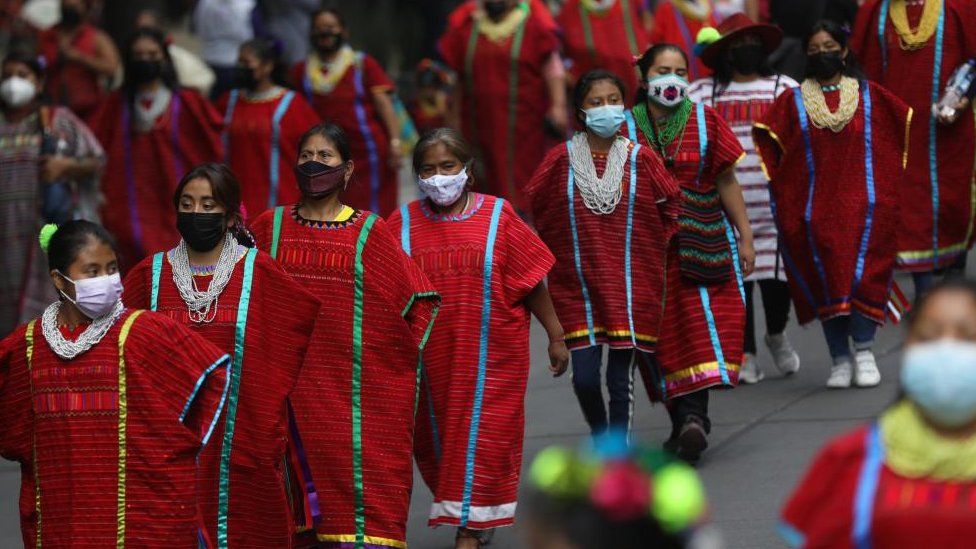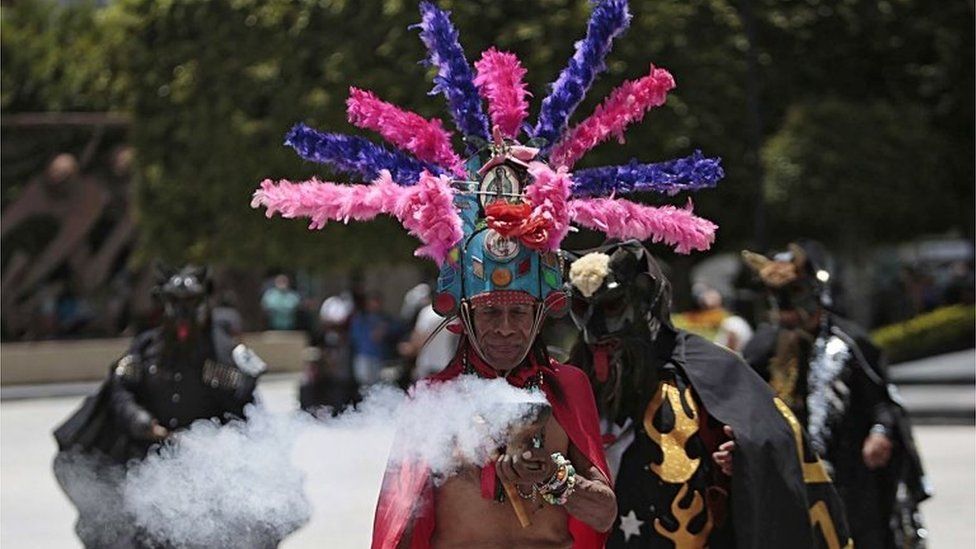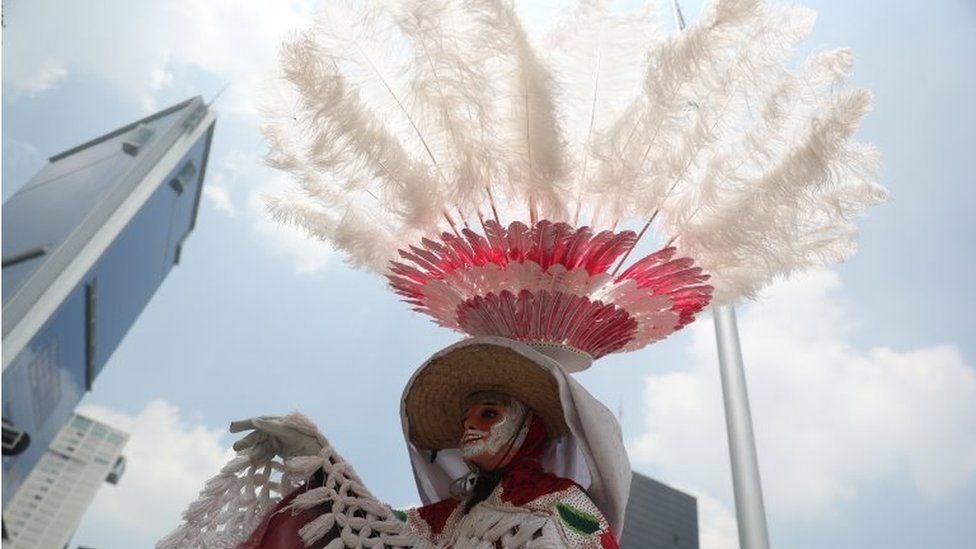So, have you ever wondered about the rich heritage of Mexico’s indigenous tribes? The vibrant culture and traditions that have been passed down for generations? Well, get ready to dive in because we’re about to take a fascinating journey into the intriguing world of Mexico’s indigenous tribes!
Mexico is a country with a rich history and a diverse cultural tapestry. Its indigenous tribes, with their unique customs and traditions, play a significant role in shaping the country’s identity. From the mighty Aztecs to the mystical Mayans, there is so much to explore and learn about these fascinating civilizations. In this article, we will delve into the customs, languages, arts, and beliefs of Mexico’s indigenous tribes, giving you a deeper understanding and appreciation for their rich heritage. So, if you’re curious to know more about the captivating world of Mexico’s indigenous tribes, keep reading and prepare to be amazed!

Unveiling the Rich Heritage of Mexico’s Indigenous Tribes
Mexico is a country brimming with a rich and diverse cultural heritage, and at its heart lies the fascinating world of its indigenous tribes. These tribes carry ancient traditions, unique art forms, and intriguing historical narratives that continue to capture the imaginations of people around the globe. From the mysterious ruins of the Mayans to the powerful empire of the Aztecs, each tribe has made significant contributions to Mexico’s history and cultural identity.
Rich and Diverse Heritage
Mexico’s indigenous tribes possess a heritage that spans thousands of years, with each tribe contributing its own unique customs and practices. The country is home to over 60 indigenous groups, each with their distinct language, traditions, and belief systems. These tribes form an integral part of Mexico’s cultural fabric and play a vital role in preserving its fascinating history.
Historical Significance
Mexican history begins with the rise of ancient civilizations, many of which were established by indigenous tribes. One of the most prominent and enigmatic tribes is the Mayans. Their civilization flourished from around 2000 BC to 1500 AD and left behind a treasure trove of historical artifacts and architectural marvels.
Cultural Practices and Traditions
The indigenous tribes of Mexico have a deep reverence for their cultural practices and traditions, which have been passed down through generations. These customs often revolve around nature, spirituality, and communal harmony. From rituals to craftsmanship, every aspect of their culture is intricately tied to their way of life.
Mayans: Guardians of the Ancient Civilization
One cannot delve into Mexico’s indigenous tribes without mentioning the Mayans. This ancient civilization continues to captivate the world with its mysterious ruins, scientific advancements, and intricate systems of writing.
Mysterious Mayan Ruins
The ancient Mayan ruins scattered across Mexico and Central America are a testament to the grandeur and sophistication of this civilization. Sites such as Chichen Itza, Tulum, and Palenque leave visitors in awe with their towering pyramids, meticulously carved stone reliefs, and ceremonial ball courts. These architectural wonders offer a glimpse into the Mayans’ advanced understanding of astronomy, mathematics, and engineering.
Mayan Calendar and Astronomy
The Mayans were renowned for their deep knowledge of astronomy, as evidenced by their remarkably accurate calendar system. The Mayan calendar, known as the Long Count, was based on intricate calculations that spanned thousands of years. Their observations of celestial bodies allowed them to develop a precise calendar that played a significant role in their religious and agricultural practices.
Ancient Mayan Writing System
One of the most remarkable aspects of Mayan civilization is their intricate writing system. The Mayans developed a sophisticated form of hieroglyphic writing, using symbols and glyphs to record historical events, religious ceremonies, and astronomical observations. These intricate inscriptions provide valuable insights into their culture, beliefs, and historical narratives.

Aztecs: The Powerful Empire of Warriors
The Aztecs, also known as the Mexica, were a dominant indigenous tribe that established a powerful empire in Mesoamerica. They built an impressive capital city, Tenochtitlan, which became one of the largest and most advanced cities of its time.
Aztec Capital: Tenochtitlan
The Aztecs chose the site where Mexico City now stands as the location for their magnificent capital, Tenochtitlan. This remarkable city was constructed on an island in Lake Texcoco and connected to the mainland by a network of causeways. It featured elaborate temples, sprawling markets, and intricate waterways, showcasing the Aztecs’ advanced engineering and urban planning skills.
Symbolism and Religion
Symbolism played a vital role in Aztec culture and religion. Their pantheon of deities was vast and diverse, with each god representing various aspects of life and nature. Human sacrifice was an integral part of Aztec religious practices, as they believed it was necessary to appease the gods and ensure the continuation of the world.
Intricate Aztec Art and Architecture
The Aztecs were renowned for their intricate art and architecture, which often blended religious symbolism with aesthetic beauty. Their artworks, including pottery, sculptures, and murals, depicted mythical creatures, gods, and historical events. The Templo Mayor, a massive pyramid in the heart of Tenochtitlan, stands as a testament to the grandeur and artistic prowess of the Aztecs.
Olmecs: The Oldest Civilization in Mexico
The Olmecs hold the distinction of being the oldest civilization in Mexico, dating back to around 1200 BC. Despite their ancient origins, the Olmecs left an indelible mark on subsequent Mesoamerican cultures and set the stage for future indigenous tribes.
Enigma of the Olmec Heads
The Olmec Heads, colossal stone sculptures depicting human faces, are one of the most intriguing legacies of this ancient civilization. Carved from enormous basalt boulders, these heads weigh several tons each and remain a mystery to archaeologists. Their existence raises questions about the Olmecs’ capabilities in carving and transporting such massive stones.
Olmec Rituals and Spirituality
The Olmecs had a complex belief system centered around shamanism and spirituality. They conducted elaborate rituals involving bloodletting and possibly human sacrifice as offerings to their gods. Shamanic practices played a vital role in Olmec society, with shamans acting as intermediaries between the spiritual and physical realms.
Olmec Influence on Later Cultures
Despite their eventual decline, the Olmecs laid the groundwork for the subsequent Mesoamerican civilizations. Many cultural and artistic elements, such as their style of artistic representation and religious beliefs, were inherited and modified by later indigenous tribes like the Mayans and the Aztecs.

Zapotecs: The Innovators of Monte Albán
The Zapotecs were innovative and creative builders, known for constructing one of the most remarkable ancient cities in Mesoamerica – Monte Albán.
Remarkable Monte Albán Ruins
Perched on a mountaintop in the Oaxaca Valley, the ruins of Monte Albán are a testament to the Zapotecs’ engineering skills and urban planning. The city features expansive plazas, towering pyramids, and intricate stone carvings. These architectural wonders showcase the Zapotecs’ ability to create grand, functional spaces that harmonize with the natural landscape.
Zapotec Social Structure
The Zapotecs developed a complex social structure that revolved around a hierarchical system. At the top were the ruling elites, followed by the nobles, commoners, and slaves. This social order was maintained through a vibrant economy based on agriculture, trade, and craft specialization.
Achievements in Mathematics and Astronomy
The Zapotecs were highly skilled in mathematics and astronomy, as evidenced by their calendar system and astronomical observations. They developed a sophisticated calendar known as the Zapotec calendar, which incorporated both solar and ritual cycles. Their knowledge of astronomy played a crucial role in agricultural planning and religious festivities.
Mixtecs: Masters of Intricate Metallurgy
The Mixtecs were renowned for their mastery of intricate metalwork, creating elaborate gold and silver artifacts that showcased their exceptional craftsmanship.
Elaborate Gold and Silver Artifacts
The Mixtecs excelled in the art of metalwork, particularly in working with gold and silver. Their skilled artisans crafted intricate jewelry, ceremonial objects, and ornamental masks that displayed their artistic prowess. These exquisite pieces exhibit detailed engravings and delicate filigree work, showcasing the Mixtecs’ dedication to perfection.
Techniques of Metalwork
The Mixtecs developed advanced techniques in metalworking, such as lost-wax casting and hammering. These methods allowed them to create intricate designs and achieve remarkable precision in their creations. The combination of technical skill and artistic vision resulted in breathtaking masterpieces that continue to inspire awe.
Mixtec Language and Traditions
The Mixtecs have preserved their unique language, which is still spoken by a significant portion of the population. Their rich oral tradition includes myths, legends, and historical accounts, which have been passed down through generations. These narratives provide valuable insights into their cultural heritage and worldview.

Toltecs: The Builders of Tula
The Toltecs were a significant influence on Central Mexican culture and left an enduring legacy through their architectural wonders, mythology, and societal practices.
The Impressive Tula Archaeological Site
The city of Tula, located in present-day Hidalgo, is home to the archaeological site of the Toltecs. This ancient city boasts monumental structures, such as the Temple of Tlahuizcalpantecuhtli and the Atlantean figures. The intricate details of these sculptures and the site’s layout demonstrate the Toltecs’ architectural prowess.
Toltec Mythology and Gods
The Toltecs had a complex mythology centered around their pantheon of gods, which included Quetzalcoatl, the Feathered Serpent deity. Quetzalcoatl played a significant role in Toltec culture and was associated with creation, wisdom, and the arts. Their myths and legends offer glimpses into the Toltecs’ spiritual beliefs and the cultural values they held dear.
Toltec Influence on Central Mexico
The Toltecs’ influence extended far beyond their own empire. They played a pivotal role in shaping Central Mexican culture, especially in religious and artistic practices. Their architectural style, characterized by elaborate stone carvings and precise symmetry, left a lasting impact on subsequent indigenous tribes.
Tarascans: The Great Mesoamerican Rival
The Tarascans, also known as the Purépecha, established a powerful empire in western Mexico that rivaled the Aztecs. Their unique social and political structure set them apart from other indigenous tribes.
Tzintzuntzan: Capital of the Tarascans
Tzintzuntzan served as the capital of the Tarascan Empire and was renowned for its impressive architectural complexes. The city boasted pyramids, palaces, and plazas, all arranged in a ceremonial and strategic manner. Its well-preserved ruins offer a glimpse into the Tarascans’ urban planning capabilities.
Unique Social and Political Structure
The Tarascans had a unique social and political structure that differed from other Mesoamerican civilizations. They had a highly centralized governance system, with a hereditary ruler known as the cazonci at the helm. The empire was divided into provinces, each governed by nobles who ensured the smooth functioning of society.
Ingenious Ceramic Art
The Tarascans were exceptional ceramic artists, renowned for their pottery and ceramic sculpture. Their techniques included incision, appliqué, and polychrome painting, resulting in vibrant and detailed designs. These exquisite works of art depicted scenes from everyday life, mythological narratives, and religious symbolism.

Huichols: Guardians of Ancient Beliefs
The Huichols, or Wixáritari, are a fascinating indigenous tribe known for their deep spiritual connection with nature and their vibrant artistry.
Sacred Peyote Rituals
The Huichols hold the sacred peyote cactus in high regard, considering it a gateway to the spiritual realm. They undertake pilgrimages to the desert to collect peyote, which they use in sacred rituals and ceremonies. These rituals, accompanied by chanting and dancing, facilitate spiritual journeys and connect the Huichols with their ancestors and the natural world.
Colorful Huichol Art and Craftsmanship
Huichol art is renowned for its vibrant colors and intricate designs. Using beads, yarn, and intricate beadwork techniques, Huichol artisans create breathtaking tapestries, masks, and sculptures that depict their spiritual beliefs and mythological stories. Each piece carries deep symbolism and reflects the Huichols’ reverence for nature and their cultural heritage.
Spiritual Connection with Nature
The Huichols have a profound spiritual connection with their natural surroundings. They believe that every aspect of the environment, from mountains to rivers to animals, possesses a spiritual essence. This reverence for nature permeates their daily lives, rituals, and art forms, highlighting the importance of preserving and respecting the natural world.
Yaquis: Warriors of Resistance
The Yaquis are a resilient indigenous tribe known for their resistance against Spanish colonization and their rich cultural traditions.
Yaqui Rebellion against Spanish Rule
The Yaquis fiercely resisted Spanish colonization, engaging in numerous skirmishes and battles. Their formidable guerrilla tactics and unity helped them maintain their independence for centuries. The Yaqui resistance serves as a testament to their unwavering spirit and determination to preserve their culture and land.
Traditional Yaqui Ceremonies
Traditional Yaqui ceremonies play a pivotal role in their community, reinforcing their cultural identity and spiritual beliefs. Ceremonies such as the Deer Dance and the Easter Rituals blend ancient indigenous practices with Catholic influences. These ceremonies showcase the unique syncretism that defines Yaqui culture.
Endurance of Yaqui Identity
Despite centuries of adversity, the Yaqui people have managed to preserve their distinct identity and traditions. Their rich oral history, language, and cultural practices continue to be passed down through generations, ensuring the endurance of their indigenous heritage.
Purepechas: Masters of Aquatic Agriculture
The Purepechas, also known as the Tarascans, are renowned for their expertise in aquatic agriculture and their distinct cuisine.
Innovative Floating Gardens of Xochimilco
The Purepechas developed a remarkable agricultural system known as chinampa, or floating gardens. These artificial islands were created by piling up mud and vegetation in shallow lakes, allowing the Purepechas to cultivate crops such as maize, beans, and squash. Xochimilco, a region in Mexico City, still showcases the remnants of this ancient agricultural technique.
Expertise in Aquatic Farming
The Purepechas’ mastery of aquatic agriculture extended beyond chinampas. They also developed intricate fish farming systems using fish traps and nets. These methods allowed them to sustain an abundant supply of fish, adding to the diversity of their diet and enhancing their overall agricultural productivity.
Distinct Purepecha Cuisine
Purepecha cuisine is renowned for its unique flavors and use of native ingredients. Dishes such as uchepos (fresh corn tamales) and pescado blanco (whitefish) reflect the Purepechas’ reliance on locally sourced ingredients and their expertise in preparing traditional recipes. Their cuisine remains a testament to their agricultural practices and culinary ingenuity.
Totonacs: Guardians of the Totonacapan
The Totonacs are an indigenous tribe that thrived in present-day Veracruz, leaving behind remarkable archaeological sites and a rich cultural legacy.
Enigmatic El Tajin Ruins
El Tajin stands as a testament to the architectural prowess of the Totonacs. The site features unique pyramids, ball courts, and intricate stone reliefs. The most famous structure, the Pyramid of the Niches, stands out for its numerous niches adorned with detailed carvings. El Tajin reflects the Totonacs’ dedication to religious practices and showcases their ancient craftsmanship.
Elaborate Totonac Rituals
The Totonacs had a rich and diverse religious system, which included rituals and ceremonies dedicated to their gods. One of their most famous ceremonies is the Voladores (Flyers) ritual, where participants suspend themselves from a pole and slowly descend, representing the flight of the sacred birds. These rituals were not only a means of worship but also a way to connect with their spiritual beliefs and foster community solidarity.
Totonac Cosmovision
The Totonacs possess a unique cosmovision, or worldview, deeply rooted in their spiritual beliefs and their relationship with nature. They perceive the world as a harmonious ecosystem, where humans, animals, and nature coexist in a delicate balance. This holistic perspective informs their daily lives and guides their interactions with the natural and spiritual realms.
Mazatecs: Shamans and Magic
The Mazatecs are an indigenous tribe known for their ancient healing practices, their sacred use of psilocybin mushrooms, and their matriarchal social structure.
Mystical Healing Practices
The Mazatecs have a long-standing tradition of healing practices, primarily led by shamans, known as curanderos or curanderas. These healers employ various techniques, such as herbal medicine, chanting, and spiritual rituals, to restore physical and spiritual well-being. The Mazatecs’ ancient healing practices continue to attract visitors seeking alternative forms of medicine and spiritual guidance.
Sacred Use of Psilocybin Mushrooms
Psilocybin mushrooms, commonly known as “magic mushrooms,” play a vital role in Mazatec spirituality and shamanic rituals. These sacred mushrooms are believed to facilitate spiritual journeys, communicate with ancestors, and offer insights into the mystical realms. The Mazatecs’ deep reverence for the mushrooms is a testament to their understanding of the power of nature and its connection to human consciousness.
Ancient Mazatec Traditions
The Mazatecs have a rich tapestry of ancestral traditions and beliefs that have been passed down through generations. Their oral history, myths, and ceremonies reflect their cosmology, spiritual practices, and cultural heritage. These traditions serve as a link between the past and the present, ensuring the continuity of Mazatec identity.
Conclusion
Mexico’s indigenous tribes possess a rich and diverse cultural heritage that spans thousands of years. From the enigmatic Mayans and powerful Aztecs to the innovative Zapotecs and resilient Yaquis, each tribe has left an indelible mark on Mexico’s history and cultural fabric. Through their traditions, practices, and artistry, these tribes continue to shape Mexico’s cultural identity and offer the world a glimpse into the mesmerizing world of Mexico’s indigenous heritage.